Telangana SCERT 6th Class Social Study Material Telangana 20th Lesson Sculptures and Buildings Textbook Questions and Answers.
TS 6th Class Social 20th Lesson Questions and Answers -Sculptures and Buildings
(Improve Your Learning)
Question 1.
Why do you think Ashoka chose lions and bulls for his pillars rather than cows or parrots? What animal would have chosen If you were in his place. Give reasons for your choice. (Conceptual Understanding)
Answer:
- The lion is a symbol of majesty discipline and strength.
- Bull is a symbol of steadfastness and hard work.
Hence lions and bulls were closen by Ashoka instead of a domestic animals like cow and a bird like parrots. I fully agree with Ashoka’s selection and chose the same for the reasons mentioned above.
Question 2.
Many stupas of Andhra Pradesh are on the banks of rivers (like Salihundam. Nagarjuna Konda Amaravati etc.) Why do you think the monks selected these sites to build stupas? (Conceptual Unders landing)
Answer:
- Water is elixir of life.
- Rivers are lifelines for mankind for water and Irrigation.
- The areas adjoining rivers are most fertile and peaceful for living.
- Water is the cheapest source of transport. Hence river banks were selected for the construction of stupas.
Question 3.
Look at the sculpture showing the calming of the elephant. Who arc the people watching the event from a height. (Conceptual Understanding)
Answer:
These people belong to Royal court or King’s palace.
Question 4.
Why do you think only the rock-cut Viharas and Chaityas have survived till today? (Conceptual Understanding)
Answer:
Rock is a solid form and takes thousands of years for its metamorphosis. Rocks are able to withstand natural calamities, Hence rock cut Viharas and Chaityas survived till today.
![]()
Question 5.
Compare the features of a Chaitya and a temple. Do you think the mode of worship in a Chaitya and a temple would be different? (Conceptual Understanding)
Answer:
- Both are temples-like structures.
- In a Chaltya, Buddha’s relic or important monks’ relics will be preserved.
- Whereas in a temple the image of god is placed for worship.
- The mode of worship is different in each case,
- Pilgrims worship the stupa by offering flowers etc., and going around it in pradakshana and meditating in front of it.
- In a temple we enter inside, stand and pray before the image of the god, and offer flowers, coconuts, and other naive dams.
Question 6.
Why are the Buddhist Stupas, Chaityas sacred? (Appreciation and Sensitivity)
Answer:
- Relies of Buddha or some important monks were preserved in Stupas.
- Chaitvas were prayer halls for the monks. Hence both of these are very sacred to Buddhist people.
Question 7.
How did the Buddhist monks probably used the Viharas and Chaltyas? (Conceptual understanding)
Answer:
Buddhist monks used Viharas for their living as well as religious education teaching places. Chaitvas were their prayer halls.
Question 8.
Locate Buddhist and lain sites on outline map of India. (Mapping skills)
Answer:

Question 9.
Viharas were the monasteries or living places of Buddhist monks where religious education was imparted. A vihara usually had small rooms around an open courtyard and had a small shrine containing a stupa or an image of the Buddha at one end. This shrine was called a chaitya, which was also a prayer hail for the monks.
Read the above (first part of page 178) and comment on it. (Reading the text (given), understanding and interpretation)
Answer:
The above-mentioned paragraph defines Viharas and Chaityas.
- Viharas are living places of Buddhist monks where education is imparted to them and physical ailments of people were treated by monks.
- Viharas usually contain small rooms around an open courtyard and had small shrines containing images or stupas of Buddha.
- Chaityas are known as prayer halls of monks.
- These holy places of Buddhists attracted pilgrims from many foreign countries.
- Many sectors of people made liberal donations for construction on Viharas.
![]()
(Project Work)
Visit a place of worship in your village or town and draw a sketch of the structure. Try to get the name of each part, its meaning and use. Prepare a report about this place of worship and conduct an exhibition in your class.
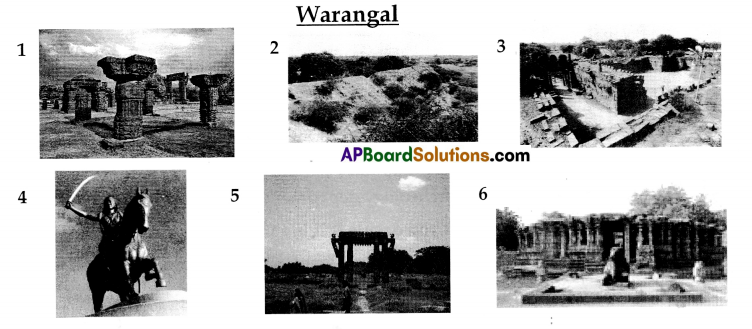
- The remains of the great temple dedicated to Siva.
- A segment of the inner earthen wall with its (dry) moat right.
- Aerial view of the eastern gateway in the City’s inner stone wall, showing the ‘Bent Entrance’ (Vankadara) and Open Courtyard (anagram. The doorway at right is the ‘great city gate’ leading to the Royal Avenue (Raja Margambu).
- Rudramadevi – Riding the Horse.
- Kirti Torana entrance of SvayamhhuSiva Temple – built by K.akatiya kings in Warangal.
- Thousand Pillars temple.
(Intext Questions)
Questions given in Box P. No.170
Question 1.
Find out the names of rivers that flow in these regions. Locate these places on a map and see how far are they from Hyderabad.
Answer:
- River Sindu and the tributaries of this river Jhelum, Chenab, Ravi, Beas, Sutlej which flows in the regions of Harappa. Mohenodaro, Kalibangan and Lothal.
- These regions are in Northern part of India. But Hyderabad is in Southern part of India which is very far to regions of northern part.
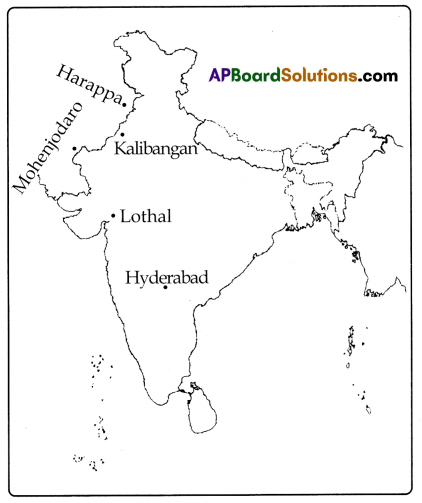
Question 2.
Do you think Telangana was part of the Harappan culture? Would the people living in Telangana have known about the Harappan people? how?
Answer:
- Telangana was not a part of the Harappa culture.
- Yes, the people living in Telangana known about the Harappa culture with the help of sources found by the archeology department through excavations.
Question 3.
If you visit a place, how will you decide if it is a village or a town?
Answer:
- The structure of a town is within planning and we can find good sanitation, underground drainage system, purified water through taps, etc.
- But in villages, the houses are not in planning. We can find cattle wealth but we can’t find either underground drainage or purified water.
Question 4.
What kind of activities go on in a city that are different from a village?
Answer:
In the following way the activities go on in a city that are different from a village.
- Cities primarily have people from three or four kinds of professions.
- Artisans like potters, metal smiths, carpenters. masons, stone cutters, etc…. traders who buy and sell things made by other people in the city.
![]()
Question 5.
How do you think archaeologists figure out from remains of ancient ruins if a place was a village or a city? Can you think of the special features in the remains of a city which will not be there in the remains of a village?
Answer:
- The archaeologists figure out if a place was a village or a city with the help of the remains have been found in that particular place.
- The special features in the remains of a city were the roads, drains, granaries, large buildings, etc.
Questions in Box Items: Text Book Page No.171
Question 6.
Do you think the ruins of the houses of rulers and houses of artisans would look similar or different? How?
Answer:
- Most of the cities were divided into two clear sections.
- Orwa high citadel in which there were some important public buildings like granaries halls and large buildings.
- Second lower part which seemed to have had residential blocks for artisans, traders, and other ordinary people.
- It appears that the rulers lived or worked in the citadel and wanted to distinguish themselves from the ordinary people.
Question 7.
Do you think it is possible to find out if there were traders in a city and where they lived by just studying the ruins?
Answer:
Yes. I think it is possible to hold out it there are traders in a city and where they lived by just studying the ruins.
Question 8.
Why do you think would the farmers have agreed to give their produce to city dwellers?
Answer:
Kings, nobles, priests, and administrators would not cultivate land or grow crops. So, the’ depended upon the grams produced by herders.
Question 9.
Do you see any difference In the layout of areas where powerful people live or work and where ordinary people live in today’s towns? Why is there a difference?
Answer:
I saw the following difference in the layout of areas where powerful people live or work and where ordinary people live in today’s towns.
1. Financial status of the people.
2. Skills and abilities of the people.
3. Educational qualifications of the people.
Questions in Box items: Text Book Page No.172
Question 10.
Do you think that the same artisans can make all these goods or different artisans were needed for making different kinds of things? Why do you think so?
Answer:
- No. I think the same artisans cannot make all these goods.
- Because of different objects like copper. silver, tin made by different kinds of people as per their skills in their profession.
Questions In Box items: Text Book Page No. 173
Question 11.
Do you know of people who have changed their livelihood – from being farmers to factory workers or office workers or shopkeepers? Or factory workers who take to odd jobs in the market? Or people who have to leave their ancestral place and go to new places in search of work? Describe their life and the problems and challenges faced by them.
Answer:
- Nowadays the people are shifting from primary sector to secondary and service sectors.
- Due to the monsoon conditions, the farmers changed their livelihoods from being farmers to factory workers, office workers, and as shopkeepers.
- The people who are leaving their ancestral places arc working in urban areas as casual workers. street ‘enters, head load workers, garment workers, and rag pickers, etc. These people are facing problems like shelter. food, drinking water, and sanitation aren’t available.
Questions given in Box P. No. 174
Question 12.
Do you feel that the lions look natural or do they look artificial posing for the sculpture?
Answer:
- The lions in the picture look quite natural.
- It is also not possible to put them like that for a photograph.
Question 13.
You must have seen these often. Where do you see pictures of these lions?
Answer:
These pictures are seen daily, many times because they were engraved on currency flotes and coins. They are the official seal of our government.
![]()
Questions given in Box P. No. 175
Question 14.
Can you compare a stupa with a temple and tell what the similarities and the differences are between them and how people worship in them?
Answer:
A stupa is a built on a platform. In the center of a stupa were buried relics of the Buddha or important monks. The hemisphere is fully packed and one cannot enter into it like a temple. Hence pilgrims worship the stupa by offering flowers etc.. and going around it in pradakshmna and meditating in front of it.
Whereas in a temple, we can enter directly, where the idol is placed and worshipped. The similarities here are bath are temples and sacred places. where people will worship respective gods.
Questions given in Box P. No. 177
Question 15.
Do you notice how they have shown a story In a panel? What could he the message of the story?
Answer:
- The picture panel is from Amaravathi.
- In this panel, calming of royal elephant Nalagiri by the Buddha was depicted.
- On seeing Buddha it calmed down and bowed to him.
- This story gives us the message that ferocious/wild/cruel animals even calm down before saints/great people.

Question 16.
What does the panel tell us?
Answer:
- The panel is from Nagaruna Konda.
- It is showing the admission of six princes and the barber Upali into the Sangha.
- Buddha admitted Upali first and the rest after him.
- This panel tells us to teach the princes humility Upali was seated on a low stool besides Buddha and Princes were admitted after Upali.
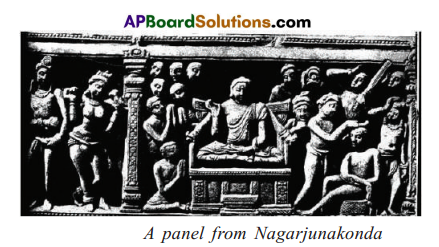
Question 17.
What does the panel show?
Answer:
- Panel shows the daily life of villagers and it is from Sanchi.
- The Panel depicts the visit of Buddha to a village.

Question 18.
Can you list the activities being done by the people in the panel?
Answer:
- Cattle rearing and farming.
- Worshipping in a temple.
- Bringing water.
- Rearing plants.
- Catering plant.
- Preparing rice
Question 19.
Do you get lo see similar scenes in today’s villages?
Answer:
More or less in Indian typical village, we find similar ones.
Questions given In Box P. No. 178
Question 20.
Do you think the man and the women shown in the sculpture had equal status? Give your reasons.
Answer:
- Both the man and women were given equal status.
- The woman though short in height was placed on a rock pedaslal to give equal height. Hence both were given equal status.
![]()
Question 21.
Which part of the Chaitya do you think was carved out first and which part was carved the last?
Answer:
Inside the Chaitva was carved out first and outside gate was carved in the last.
Additional Questions
Question 1.
What are the archaeological finding,s of Indus Valley?
Answer:
- Nice stone and bronze sculptures.
- seals cared on stones.
- Baked clay figures.
Question 2.
What do you know about Mauryan period sculptures?
Answer:
- Mauryan period sculpture belongs to around 2200 years ago.
- King Mhoka set up tall, smooth polished pillars in many places.
- Messages of Asoka were carved on them,
- Ashokan pillars had some figures of animals at their top called capitals.
Question 3.
What is lion capital of Sarnath?
Answer:
- It is one of the famous pillars of Ashoka.
- It was set up in Sarnath where the Buddha first preached his teachings.
- There are four majestic lions facing the four directions holding on their head and the wheel of Dharma.
- These pillars and the lion capital represent the power and majesty of the Mauran emperors.
Question 4.
How the Stupas were built?
Answer:
- A stupa was built on a platform.
- At the center ola, stupa relics of the Buddha or important monks were buried.
- The hemisphere is fully packed and one cannot enter into it like a temple.
- Above it rises a pillar topped up by umbrellas.
- The stupas are usually surrounded by a stone fences with decorated gateways.
Question 5.
How Stupas were made initially?
Answer:
Initially, in the time of Ashoka these were built of mud, brick, and wood and later on made with stones.
Question 6.
Where the remains of stupas of earlier times were found?
Answer:
Remains of Stupas of earlier times were found in Amaravathi, Bhattiprolu, Ramatirtham, Salihundam etc. in Andhra Pradesh.
Question 7.
Write a note on Amaravati Stupa.
Answer:
- Amaravati stupa in Guniur District was built during the rule of Satavahanas about 1900 years ago.
- There are some lIving figures on thy top of the stupa supposed to be gods from heavens who came to worship the Buddha.
- At the bottom, we can see sonic men and women worshipping.
- We can also see four lions on the gateway.
Question 8.
What is the status of Amaravathi Stupa now?
Answer:
- It is just a mound of rubble.
- Some of the panels of the stupa were taken away by the British to London,
- Some more that could not ht’ transported were kept in Madras Museum.
![]()
Question 9.
Write about Nagarjuna Konda Stupa?
Answer:
- Nagarjuna Ronda Stupa was on tite banks of river Krishna.
- Vijavapuri had a large number of Stupas, viharas, and palaces.
- It also had a beautifully designed amphitheater and ghats leading to river.
- The entire city; submerged in the Nagarjuna Sagar dam and a large number of sculptures and other remains were kept in a museum nearby.
Question 10.
Where do you find famous sculptures of Buddha?
Answer:
- The most famous sculptures of the Buddha come from Gandhara in Northwest.
- Mathura and Sarnath in Uttar Pradesh.
- We can also see some of these in Nagarjuna Ronda,
Question 11.
Which are known as Viharas?
Answer:
Viharas were the monasteries or living places of Buddhist monks where religious education was imparted.
Question 12.
What are the activities in Viharas?
Answer:
- In viharas, monks taught Buddhist scriptures to disciples.
- Monks were also treating the physical ailments of people in Viharas,
Question 13.
Name some cave
Answer:
Nashik and Karle.
Question 14.
Name the Viharas which are greatest places of learning?
Answer:
Takshasila, Nagarjuna Ronda and Nalanda.
Question 15.
Who helped to build Viharas?
Answer:
Ordinary men and women farmers traders, soldiers, and artisans-made liberal donations for building and expenses of these Viharas.
Question 16.
Name the Chinese pilgrims who visited Buddhist holy places?
Answer:
Fa-hi-an, Itsing, and Huen-Tsang from China came to visit places associated with the life of the Buddha as well as famous monasteries.
![]()
Question 17.
Who are Pilgrims?
Answer:
Pilgrims were the people who took up journeys to holy places to offer worship.
Question 18.
Describe the earliest stone temple of Sanchi?
Answer:
- This was built around 1600 years ago.
- This is a very simple structure with garbhagriha (small room) in which the idol of the Buddha was kept.
- A small mandapa is there with no walls hut only pillars.
- The door and the pillan were beautifully caned.
- The temple had a flat roof without any Shikhara on it.
Question 19.
What do the pictures tell:
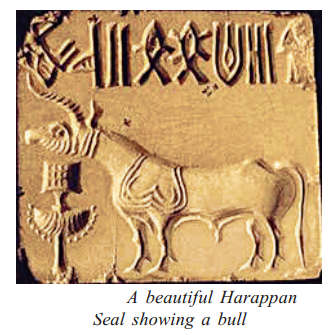
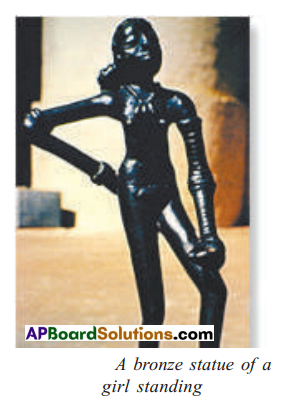
Answer:
1. The picture ‘A’ shows a beautiful Harappan seal showing a hull. The picture ‘B’ shows bronze statue of a girl standing. These belong to Indus Valley and were made 4000 years ago. These depict everything in natural manner.
2. This is famous lion capital of Saranadh set up by Ashoka in the place where Budha preached his first teaching. The lion capital represents the power and majesty of the &taurvan emperors.
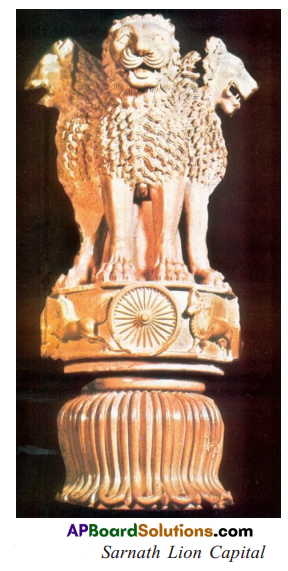
3. This is the Sanchi stupa in Madhya Pradesh It is one of the most important stupas built by King Ashoka. Above it rises a pillar topped by umbrellas. The stupa is usually surrounded by a stone fence with decorated gateways.
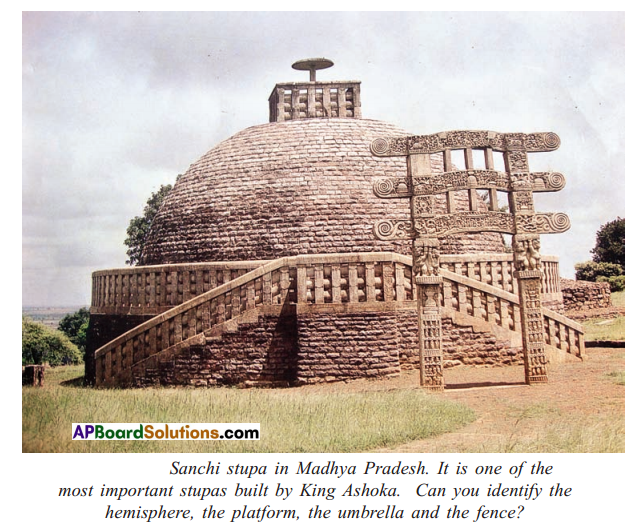
4. This is Amaravati Stupa in Guntur district, the most famous one in Andhra Pradesh. This was built during the rule of Satav Ahanas about 1900 years ago.

(Reading The Text (Given), Understanding And Interpretation)
I. Given below is the picture of role of the most famous stupas in India – the Sanchi Stupa. Look at the photo. You can see that it is like a hemisphere (half ball) – just as the way the sky looks when you look up. A stupa is built on a platform. In the center of a stupa were buried relics of the Buddha or important monks (relics are remains or the body like teeth, bone, hair, etc).

The hemisphere is fully packed and you cannot enter it like a temple. Above it rises a pillar topped by umbrellas. The stupa is usually surrounded by a stone fence with decorated gateways, Initially in the time of Ashoka, these were built of mud, brick, and wood but later on made with stones.
Q. How were stupas built?
Answer:
1. A stupa was built on a platform.
2. At the center of a stupa relics of the Buddha or important monks were buried.
3. The hemisphere is fully packed and one cannot enter into it like a temple.
4. Above it rises a pillar topped up by umbrellas.
5. The stupas are usually surrounded by a stone fence with decorated gateways.
(Appreciation And Sensitivity)
Question 1.
Why traders, artisans are donating liberally to build Chaityas and Viharas?
Answer:
- These are sacred places where pious and learned people encouraged to live.
- They propagate Dharma and good among the public.
- Hence people like traders, artisans who had enough money donated liberally to build Chaitvas and Viharas.
Question 2.
How Buddha equated Princes and common people?
Answer:
- Buddha admitted barber Lipali into Buddha Sangha first and asked him to sit beside him on a low stool.
- Buddha admitted six prices into Sangha after Upali’s admission to teach humility to Princes
Two Marks Question
Question 1.
Name some of the Buddhist places which you know other than given in textbook.
Answer:
Ghantasala, Jaggayyapet, elakondapalli, Thotladkonda etc.
![]()
Question 2.
Why traders, artisans are donating liberally to build Chiatyas and Viharas?
Answer:
‘These are sacred places where pious and learned people encouraged live. They propagate Dharma and good among the public. Hence people are donating to such activities liberally.
Question 3.
Why horses were taken on lion capital of Saranath?
Answer:
Horse represents energy, loyalty, and speed.
Question 4.
What does Indian National Emblem i.e., Sarnath lion capital represent?
Answer:
Indian National Emblem represents the authority or the government.
Question 5.
What the chakra in Sarnath lion capital signifies?
Answer:
Chakra is the symbol of Progress and movement.
Question 6.
How Buddha equated Princes and common people?
Answer:
- Buddha admitted barber Upali into Buddha Sangha first and asked him to sit beside him on a low stool.
- Buddha admitted sis princes into Sangha after Upali’s admission to teach humility to Princes.
Question 7.
Can you name some of the rock-cut cave temples?
Answer:
Ajanta, Ellora and Undavalli caves.
![]()
Question 8.
Why lion capital of Sarnath is in news even today?
Answer:
- It is here where Buddha first preached his teachings.
- Lion capital of Samath is adopted as our national emblem br theGovernment of India.
(Objective Type Questions)
Question 1.
Indus Valley sculptures belong to
A) 2000 years
B) 4000 years
C) 1000 years
D) 1600 years
Answer:
B) 4000 years
Question 2.
What do you see on Harappan seal ( )
A) Head of a kind
B) Lion capital
C) Bull
D) Horse
Answer:
C) Bull
Question 3.
Buddha preached first his teachings at ( )
A) Saranath
B) Kusinagar
C) Gaya
D) Lumbini
Answer:
A) Saranath
Question 4.
According to Buddhists remains of the body like teeth, bone, hair, etc., are called ( )
A) Stupa
B) Vihara
C) Chaitva
D) Relic
Answer:
D) Relic
Question 5.
Sanchi Stupa is in ( )
A) Madhya Pradesh
B) Bihar
C) Uttar Pradesh
D) Andhra Pradesh
Answer:
A) Madhya Pradesh
![]()
Question 6.
Amaravathi Stupa in Guntur District was built by ( )
A) Pallavas
B) Cholas
C) Satavahanas
D) Nagarjuna
Answer:
C) Satavahanas
Question 7.
The name of the royal elephant calmed down by Buddha was ( )
A) Nalagiri
B) Himagiri
C) Hasthi
D) Iravat
Answer:
A) Nalagiri
Question 8.
Hu-en-Tsang spent time in studying in ( )
A) Nagarjuna Konda
B) Amaravathi
C) Takshasila
D) Nalanda
Answer:
D) Nalanda
Question 9.
Karle Chaitya was built ( )
A) 4000 years ago
B) 1000 years ago
C) 2100 years ago
D) 5000 years ago
Answer:
C) 2100 years ago
Question 10.
The earliest surviving stone temple can be found at ( )
A) Karle
B) Sanchi
C) Nalanda
D) Takshasila
Answer:
B) Sanchi